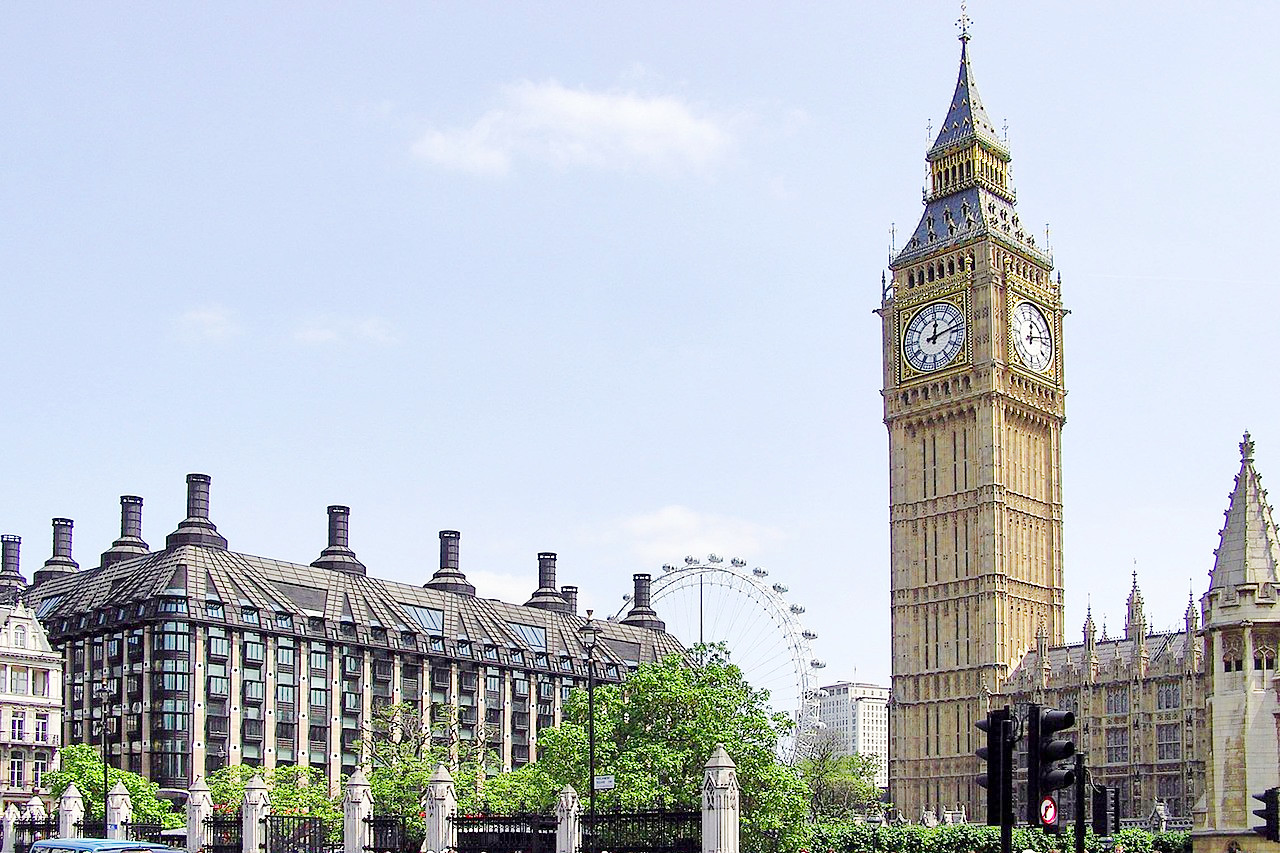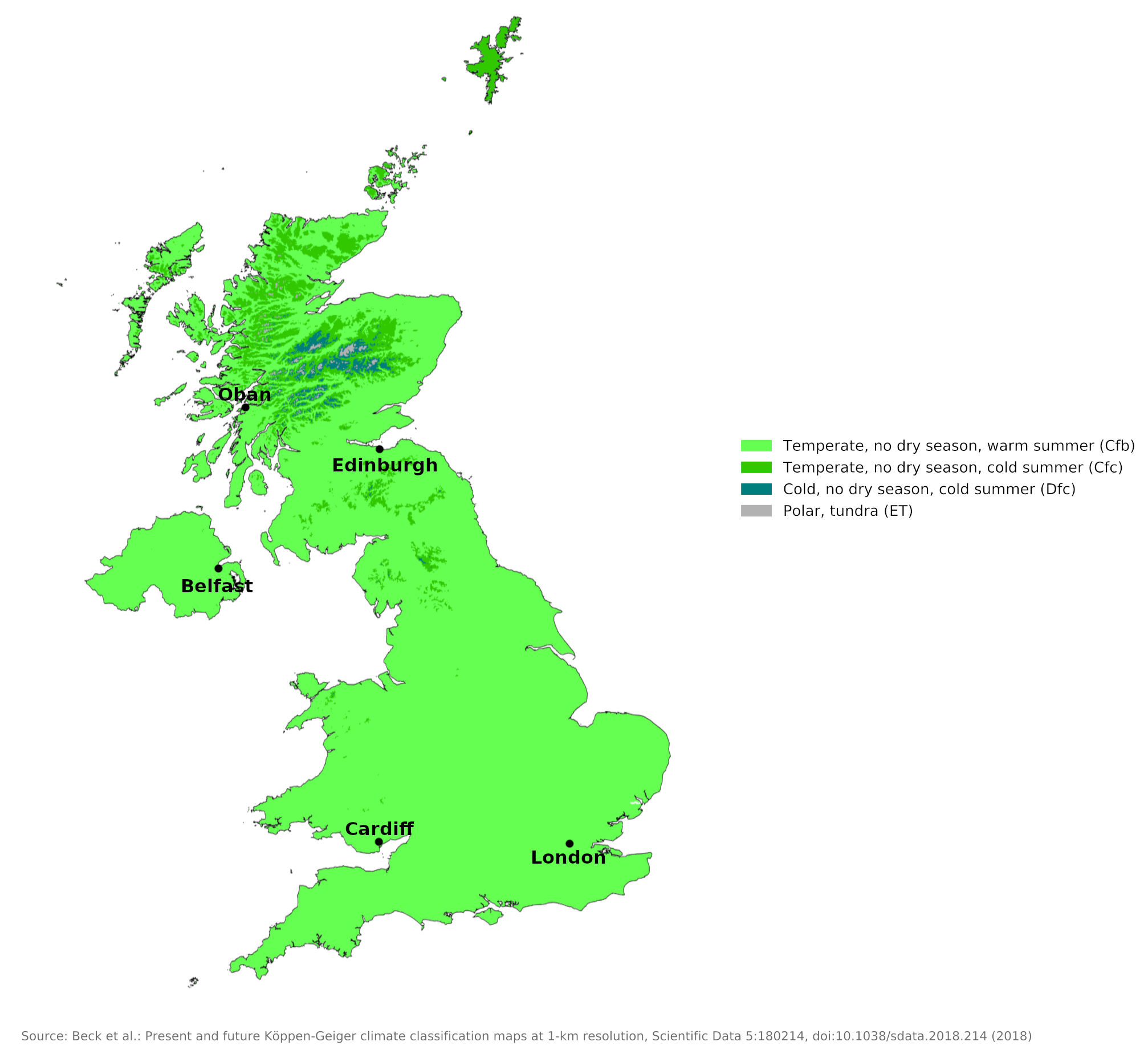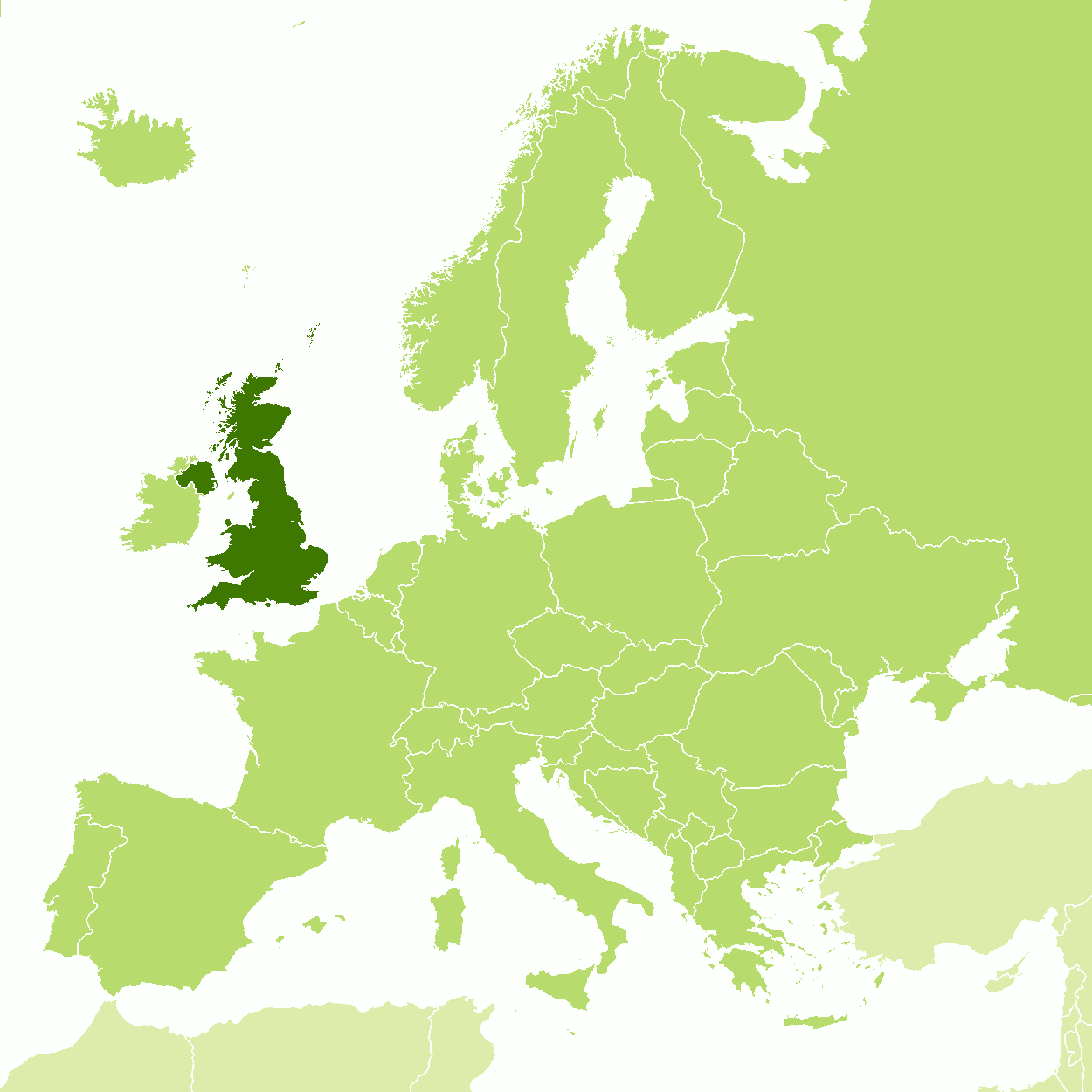The Climate of the
United Kingdom
 Portcullis House, the London Eye, and Big Ben
Portcullis House, the London Eye, and Big Ben
Climate Map
 Climate map of the United Kingdom
Climate map of the United Kingdom
What is the climate of the United Kingdom like?
The United Kingdom (UK) is located off the northwestern coast of Europe. It consists of England, Wales, and Scotland, on the island of Great Britain; and Northern Ireland, on the island of Ireland. The country lies between 50° and 60°N.
Despite its northern latitude, the UK enjoys a generally temperate climate, warmed by the North Atlantic Current, a continuation of the Gulf Stream, and by south-west winds. Temperatures rarely rise above 32°C (90°F) in summer or fall below -10°C (14°F) in winter. But the weather is notoriously variable, changing from day to day. The weather is generally cool to mild with frequent clouds and rain, but occasional periods of steady weather occur throughout the year.
Scotland, despite its more northerly latitude, is rarely much colder than England. However, summers in Scotland are typically shorter and rather cooler. Wales, western Scotland and Northern Ireland are wetter than most of England all year round. However, Northwest England and the Lake District will be particularly wet and overcast. Whilst the south is typically slightly warmer than the north and the west wetter than the east, the constant changes in UK weather mean these differences can occasionally reverse. Weather extremes are rare in the UK but they do happen.
Averaging around 1,000 millimeters (40 inches) of rainfall across the UK, rainfall is heaviest on the western and northern highlands and lightest on the east and south-east coasts. The greatest weather and climate extremes in Britain occur in the mountains of Scotland, Wales and northern England. Here at elevations over 600 meters (2,000 feet), conditions are wet and cloudy most of the year, with annual rainfall exceeding 1,500 millimeters (60 inches) and up to 5,000 millimeters (200 inches) in some places. These are among the wettest places in Europe.
In winter, or even spring, there can be snow all over Britain, but except in the hills, it rarely lasts more than a few days. Some winters there may be very little snow, but every fifteen or twenty years there may be a few weeks during a prolonged cold spell. There is occasional heavy snowfall in the Scottish mountains, but conditions are not particularly good for skiing and there has been limited development of winter sports resorts. Due to the extreme conditions that can occur very suddenly on mountains, hikers and climbers who are unprepared are at risk of catching a cold or even freezing to death. Conditions can vary greatly from what the weather at lower levels would suggest.
Most cities in the UK are below 300 meters (1,000 feet) and weather conditions are usually pleasant at these elevations. In general, the west side of Britain is cloudier, wetter and milder in winter, with cooler summers than the east. Conditions on the west side of the UK are represented by those for Oban (Scotland), Belfast (Northern Ireland) and Cardiff (Wales).
| Climate data for Oban (1971–2000) | |||||||||||||
|---|---|---|---|---|---|---|---|---|---|---|---|---|---|
| Month | Jan | Feb | Mar | Apr | May | Jun | Jul | Aug | Sep | Oct | Nov | Dec | Year |
| Average high °C (°F) | 7.0 (44.6) | 7.2 (45.0) | 8.6 (47.5) | 11.0 (51.8) | 14.5 (58.1) | 16.2 (61.2) | 17.7 (63.9) | 17.7 (63.9) | 15.4 (59.7) | 12.6 (54.7) | 9.4 (48.9) | 7.9 (46.2) | 12.1 (53.8) |
| Daily mean °C (°F) | 4.6 (40.3) | 4.7 (40.5) | 5.8 (42.4) | 7.6 (45.7) | 10.6 (51.1) | 12.5 (54.5) | 14.3 (57.7) | 14.3 (57.7) | 12.4 (54.3) | 10.0 (50.0) | 6.9 (44.4) | 5.5 (41.9) | 9.1 (48.4) |
| Average low °C (°F) | 2.1 (35.8) | 2.2 (36.0) | 3.0 (37.4) | 4.2 (39.6) | 6.6 (43.9) | 8.8 (47.8) | 10.9 (51.6) | 10.9 (51.6) | 9.3 (48.7) | 7.3 (45.1) | 4.3 (39.7) | 3.0 (37.4) | 6.1 (43.0) |
| Average precipitation mm (inches) | 192.2 (7.57) | 139.5 (5.49) | 153.2 (6.03) | 80.1 (3.15) | 67.0 (2.64) | 82.6 (3.25) | 102.4 (4.03) | 119.2 (4.69) | 163.3 (6.43) | 186.9 (7.36) | 182.1 (7.17) | 192.4 (7.57) | 1,660.9 (65.39) |
| Source: Met Office | |||||||||||||
| Climate data for Belfast (1991–2020) | |||||||||||||
|---|---|---|---|---|---|---|---|---|---|---|---|---|---|
| Month | Jan | Feb | Mar | Apr | May | Jun | Jul | Aug | Sep | Oct | Nov | Dec | Year |
| Average high °C (°F) | 8.2 (46.8) | 8.8 (47.8) | 10.5 (50.9) | 12.8 (55.0) | 15.7 (60.3) | 17.2 (63.0) | 19.7 (67.5) | 19.4 (66.9) | 17.3 (63.1) | 13.8 (56.8) | 10.7 (51.3) | 8.4 (47.1) | 13.7 (56.7) |
| Daily mean °C (°F) | 5.2 (41.4) | 5.5 (41.9) | 6.8 (44.2) | 8.8 (47.8) | 11.4 (52.5) | 14.0 (57.2) | 15.6 (60.1) | 15.4 (59.7) | 13.5 (56.3) | 10.4 (50.7) | 7.4 (45.3) | 5.4 (41.7) | 9.9 (49.8) |
| Average low °C (°F) | 2.2 (36.0) | 2.1 (35.8) | 3.1 (37.6) | 4.7 (40.5) | 7.0 (44.6) | 9.7 (49.5) | 11.6 (52.9) | 11.5 (52.7) | 9.6 (49.3) | 6.9 (44.4) | 4.2 (39.6) | 2.3 (36.1) | 6.3 (43.3) |
| Average precipitation mm (inches) | 88.5 (3.48) | 70.3 (2.77) | 71.4 (2.81) | 60.4 (2.38) | 59.6 (2.35) | 69.0 (2.72) | 73.6 (2.90) | 85.0 (3.35) | 69.6 (2.74) | 95.8 (3.77) | 102.3 (4.03) | 93.3 (3.67) | 938.7 (36.96) |
| Source: Met Office | |||||||||||||
| Climate data for Cardiff (1991–2010) | |||||||||||||
|---|---|---|---|---|---|---|---|---|---|---|---|---|---|
| Month | Jan | Feb | Mar | Apr | May | Jun | Jul | Aug | Sep | Oct | Nov | Dec | Year |
| Average high °C (°F) | 8.6 (47.5) | 9.2 (48.6) | 11.3 (52.3) | 14.4 (57.9) | 17.4 (63.3) | 20.1 (68.2) | 21.8 (71.2) | 21.4 (70.5) | 19.1 (66.4) | 15.3 (59.5) | 11.6 (52.9) | 9.1 (48.4) | 15.0 (59.0) |
| Daily mean °C (°F) | 5.6 (42.1) | 5.9 (42.6) | 7.6 (45.7) | 10.1 (50.2) | 13.0 (55.4) | 15.7 (60.3) | 17.5 (63.5) | 17.2 (63.0) | 14.9 (58.8) | 11.7 (53.1) | 8.3 (46.9) | 6.0 (42.8) | 11.1 (52.0) |
| Average low °C (°F) | 2.5 (36.5) | 2.5 (36.5) | 3.9 (39.0) | 5.7 (42.3) | 8.5 (47.3) | 11.1 (52.0) | 13.1 (55.6) | 12.9 (55.2) | 10.7 (51.3) | 8.0 (46.4) | 4.9 (40.8) | 2.8 (37.0) | 7.3 (45.1) |
| Average precipitation mm (inches) | 127.0 (5.00) | 93.0 (3.66) | 85.3 (3.36) | 72.1 (2.84) | 78.5 (3.09) | 73.5 (2.89) | 83.6 (3.29) | 104.8 (4.13) | 86.3 (3.40) | 129.1 (5.08) | 130.7 (5.15) | 139.6 (5.50) | 1,203.5 (47.39) |
| Source: Met Office | |||||||||||||
The east side of Britain is drier all year round, with summer rain tending to be heavier than winter rain. The east is slightly colder in winter and warmer in summer. Edinburgh (Scotland) and London (England) are representative of conditions in the east. Much of central England has weather very similar to that of the east and south of the country. Southwest England shares the greater summer warmth of southern England but tends to experience milder and wetter winters than the east of the country.
| Climate data for Edinburgh (1991–2020) | |||||||||||||
|---|---|---|---|---|---|---|---|---|---|---|---|---|---|
| Month | Jan | Feb | Mar | Apr | May | Jun | Jul | Aug | Sep | Oct | Nov | Dec | Year |
| Average high °C (°F) | 7.3 (45.1) | 8.0 (46.4) | 9.7 (49.5) | 12.2 (54.0) | 14.9 (58.8) | 17.4 (63.3) | 19.3 (66.7) | 19.1 (66.4) | 16.9 (62.4) | 13.4 (56.1) | 9.9 (49.8) | 7.3 (45.1) | 13.0 (55.4) |
| Daily mean °C (°F) | 4.5 (40.1) | 4.8 (40.6) | 6.3 (43.3) | 8.4 (47.1) | 11.0 (51.8) | 13.7 (56.7) | 15.4 (59.7) | 15.3 (59.5) | 13.3 (55.9) | 10.0 (50.0) | 6.8 (44.2) | 4.5 (40.1) | 9.5 (49.1) |
| Average low °C (°F) | 1.7 (35.1) | 1.7 (35.1) | 2.9 (37.2) | 4.7 (40.5) | 7.1 (44.8) | 9.9 (49.8) | 11.6 (52.9) | 11.5 (52.7) | 9.7 (49.5) | 6.7 (44.1) | 3.8 (38.8) | 1.6 (34.9) | 6.1 (43.0) |
| Average precipitation mm (inches) | 64.7 (2.55) | 53.1 (2.09) | 48.5 (1.91) | 40.8 (1.61) | 47.6 (1.87) | 66.2 (2.61) | 72.1 (2.84) | 71.6 (2.82) | 54.9 (2.16) | 75.7 (2.98) | 65.3 (2.57) | 67.4 (2.65) | 727.7 (28.65) |
| Source: Met Office | |||||||||||||
| Climate data for London (1991–2020) | |||||||||||||
|---|---|---|---|---|---|---|---|---|---|---|---|---|---|
| Month | Jan | Feb | Mar | Apr | May | Jun | Jul | Aug | Sep | Oct | Nov | Dec | Year |
| Average high °C (°F) | 8.4 (47.1) | 9.0 (48.2) | 11.7 (53.1) | 15.0 (59.0) | 18.4 (65.1) | 21.6 (70.9) | 23.9 (75.0) | 23.4 (74.1) | 20.2 (68.4) | 15.8 (60.4) | 11.5 (52.7) | 8.8 (47.8) | 15.7 (60.3) |
| Daily mean °C (°F) | 5.6 (42.1) | 5.8 (42.4) | 7.9 (46.2) | 10.5 (50.9) | 13.7 (56.7) | 16.8 (62.2) | 19.0 (66.2) | 18.7 (65.7) | 15.9 (60.6) | 12.3 (54.1) | 8.4 (47.1) | 5.9 (42.6) | 11.7 (53.1) |
| Average low °C (°F) | 2.7 (36.9) | 2.7 (36.9) | 4.1 (39.4) | 6.0 (42.8) | 9.1 (48.4) | 12.0 (53.6) | 14.2 (57.6) | 14.1 (57.4) | 11.6 (52.9) | 8.8 (47.8) | 5.3 (41.5) | 3.1 (37.6) | 7.8 (46.0) |
| Average precipitation mm (inches) | 58.8 (2.31) | 45.0 (1.77) | 38.8 (1.53) | 42.3 (1.67) | 45.9 (1.81) | 47.3 (1.86) | 45.8 (1.80) | 52.8 (2.08) | 49.6 (1.95) | 65.1 (2.56) | 66.6 (2.62) | 57.1 (2.25) | 615.0 (24.21) |
| Source: Met Office | |||||||||||||
The average number of hours of sunshine is highest in the south and south-east of England and least in the north and west. Western Scotland, Wales and Northern Ireland get slightly less sunshine than most of England. The daily hours of sunshine range from one to two in midwinter to between five and seven in midsummer. The winter sun is greatly reduced due to frequent fog and low clouds. This is a result of the winds blowing in from the Atlantic and seas around Britain bringing high levels of humidity with them. British mountains are particularly cloudy and wet for the same reason.
The country enjoys long summer days, which are a result of the northern latitude; In the north of Scotland, in midsummer, the day is eighteen hours long and twilight lasts all night. Conversely, winter days are short. The frequent changes in weather affect all parts of the country equally; there are not big differences from one part of the country to another. Visitors to the UK will rarely experience severe or inclement weather for long unless they venture onto the hills. However, be prepared for rapid weather changes at any time of the year.
References
- E. A. Pearce, Charles Gordon Smith, (1990) The Hutchinson World Weather Guide, John Murray Press. ISBN 1859863426
- Timothy L. Gall, (ed.), (2003), Worldmark Encyclopedia of the Nations, Eleventh Edition, Thomson Gale
- Hugh Chisholm, (ed.), (1911), Encyclopædia Britannica, Eleventh edition, Cambridge University Press
The Climate of the
United Kingdom

In summary:
The United Kingdom enjoys a temperate climate, warmed by the North Atlantic Drift, with the temperature rarely exceeding 32°C (90°F) in the summer months or dropping below -10°C (14°F) in the winter. During the winter, mean monthly temperatures range from 3°C (37°F) to 5°C (41°F). Mean summertime temperatures range from 14°C to 19°C (57°F to 66°F).
Average annual rainfall across the country is around 1000 mm (40 inches), with rain distributed evenly throughout the year. Rainfall is lightest along the eastern and southeastern coasts, and heaviest on the western and northern heights, where it can exceed 3800 mm (150 in).